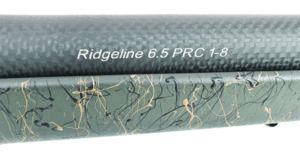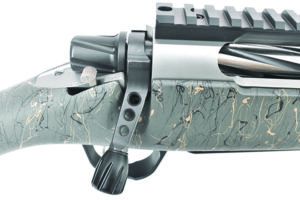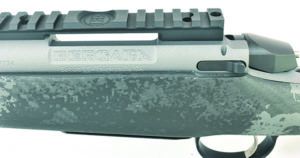GUN TESTS GRADE: A (OUR PICK)
$1793
Like the Bergara, Christensen Arms also sets the Ridgeline rifles up for those who may want to walkabout, but Christensen uses different barrel technology in its design. The Christensen barrel is 416R stainless measuring right at 1.20 inches at the receiver and 0.92 inches at the muzzle — and weighs almost nothing. That is because most of the bulk is an aero-grade carbon-fiber wrap. According to Christensen, the carbon-wrapped barrel brings several advantages over conventional steel barrels. Christensen claims these are lightweight barrels with the accuracy of a target bull barrel, three times stiffer than a steel barrel of equal weight. They tout the zero thermal expansion coefficients, which brings you shot after shot consistency and which performs well in any climate or temperature, and corrosion resistance. Literature says heat dissipates from the stainless-steel barrel with liner 300% faster than steel only, which can help extend barrel life by 25%. This is the first time this particular crew has worked extensively with a wrapped barrel, so we were very curious as to how these claims worked out.
| Action Type | Bolt |
| Overall Length | 43.75 in. with thread protector |
| Barrel Length | 24 in., 1:8 twist |
| Overall Height w/o Scope Mount | 6.25 in. |
| Weight Unloaded | 6.3 lbs. |
| Weight Loaded | 6.6 lbs. |
| Sight Radius | NA |
| Action Finish | Stainless steel |
| Barrel Finish | Stainless steel and carbon-fiber wrap |
| Magazine Capacity | 3 |
| Magazine Type | Internal box with hinged baseplate |
| Stock | Carbon-fiber composite |
| Drop at Comb | 0.6 in. |
| Drop at Heel | 0.8 in. |
| Bedding | Spot bedding |
| Buttplate | Limbsaver |
| Length of Pull | 13.75 in. |
| Receiver Scope-Base Pattern | STD 6-48 Remington 700 |
| Trigger Pull Weight | 3.1 lbs. |
| Safety | Two-position rocker |
| Warranty | Limited lifetime for original owner |
| Telephone | (888) 517-8855 |
| Website | ChristensenArms.com |
| Made In | USA — Utah |

The 24-inch 1-in-8-twist barrel gets some love before it ever goes on your rifle. It comes with a match chamber on a button-rifled hand-lapped bore. The barrel is free floated from the recoil lug forward. It ends at the muzzle in 5⁄8 x 24 threads and a stainless-steel thread protector.
The stock is a sporter-style, also made of carbon-fiber composite. The forend is very trim and rounded. We chose the green with black-and-tan webbing. It is also available in black with gray webbing. Invar pillars are used to keep the shooter from torquing the action in too tightly, and we could see spot bedding around the recoil lug. All said, the action fit very snugly inside the stock. It is equipped with the customary pair of sling swivel studs and is capped by a good Limbsaver recoil pad.

The action on our rifle had a brushed-stainless finish with lightening cuts milled into the receiver as well as an oversized ejection port. The twin-lug bolt is spiral fluted and nitride treated to help with corrosion resistance and lubricity. It uses an M16-style extractor and, as on all Christensen Ridgelines chambered in magnum calibers (or just fat cases that really resemble magnum calibers), it comes with dual ejectors. In their effort to save just a little more weight, the bolt knob has been fluted and the bolt handle skeletonized.
The Ridgeline also ships with the Trigger Tech Field trigger. The Trigger Tech had virtually no take up and almost no overtravel. Adjustment is simple with an easily accessed Allen screw visible just in front of the trigger proper, without no disassembly needed. Rotating that screw counter-clockwise lowers the amount of compression needed to release the sear. Our rifle started with a trigger pull of 3.1 pounds. Six tactile and audible clicks later, we were down to just less than 2.5 pounds.

The Christensen Arms Ridgeline came in second place in the accuracy contest, slightly, to the Bergara at 0.63 inch, averaging 0.72-inch three-shot groups over two different kinds of ammunition. What won us over was the addition of a very effective muzzle brake and the carbon-fiber-wrapped barrel. When we removed the muzzle brake, we only noticed about 0.1 mil (.36 inches at 100 yards) change in point of impact. We were a bit surprised that the 24-inch barrel of the Christensen lost less than 0.5% of the muzzle velocity achieved by the 26-inch barrel Browning.
Also, we were curious about how these tubes heated, so we used a Helect infra-red thermometer, which showed us the carbon-fiber wrap did indeed heat up more slowly and cool down more quickly than the steel-only barrels, while maintaining accuracy.
Our Team Said: Lightweight with an accurate, match-chambered, button-rifled, hand-lapped, stainless-steel barrel, the Ridgeline had a lot of advantages, one of which was the carbon-wrapped barrel, along with the option to use a muzzle brake. We thought the Christensen brought a slight advantage in utility over the others, and we declared it our winner. We would hate to have to live on the difference between these rifles.
We quickly became big fans of this innovative cartridge and didn’t really want to end the tests, so we didn’t. We also obtained a Seekins Havak PH2 in 6.5 PRC and a Weatherby Mark V Backcountry in the new 6.5 RPM chambering. We will have test results on those soon as we compare them to the Christensen Arms Ridgeline.
Range Data
| Hornady 143-grain ELD-X | Browning X-Bolt | Bergara Mountain | Christensen Arms Ridgeline |
| Average Velocity | 2993 fps | 2961 fps | 2990 fps |
| Muzzle Energy | 2846 ft.-lbs. | 2785 ft.-lbs. | 2840 ft.-lbs. |
| Best Group | 0.91 in. | 0.38 in. | 0.76 in. |
| Average Group | 1.1 in. | 0.41 in. | 0.88 in. |
| Hornady 147-grain ELD-M | Browning X-Bolt | Bergara Mountain | Christensen Arms Ridgeline |
| Average Velocity | 2957 fps | 2921 fps | 2940 fps |
| Muzzle Energy | 2854 ft.-lbs. | 2785 ft.-lbs. | 2823 ft.-lbs. |
| Best Group | 0.40 in. | 0.62 in. | 0.46 in. |
| Average Group | 0.56 in. | 0.88 in. | 0.56 in. |
| Cumulative Average Group | 0.83 in. | 0.64 in. | 0.72 in. |


























